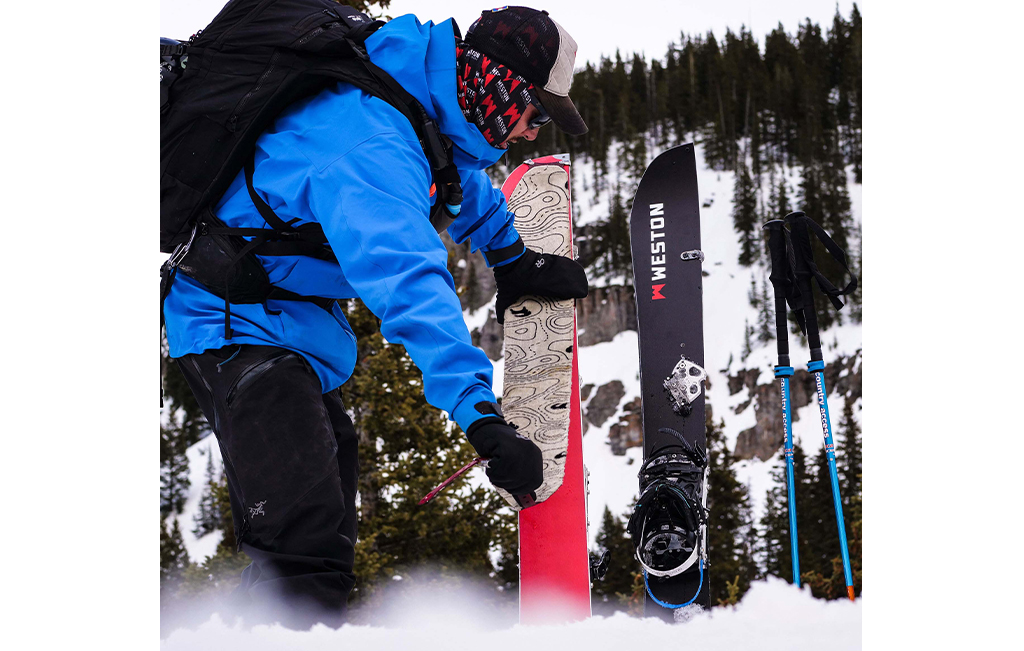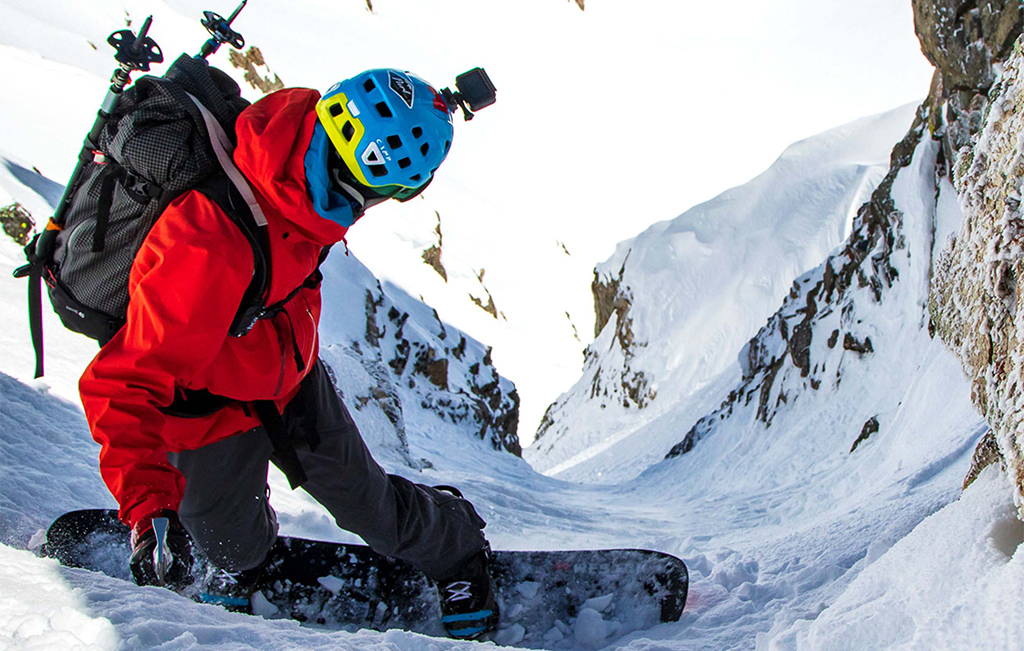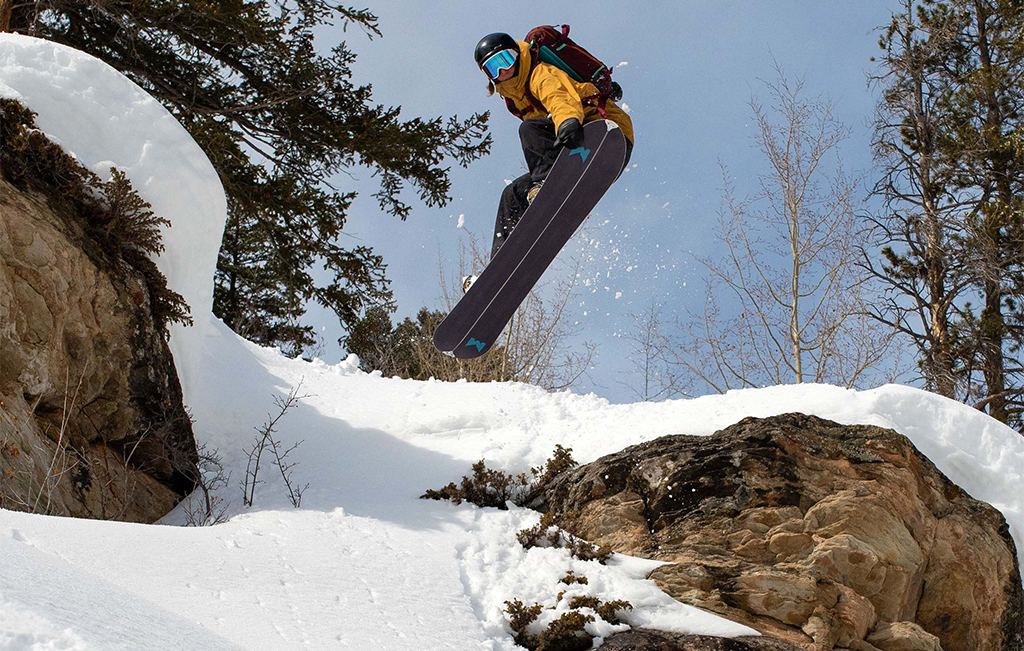Pat Gephart lives a double life. To pay the bills, he does some freelance software engineering, but between projects, the 33-year-old splitboarder would rather be in the mountains. “No set schedule, no boss, that’s the key for me,” says Pat, who lives in Breckenridge, Colorado, where he typically balances his time away from the keyboard snowboarding, ice climbing, splitboard guiding and—on the rare days when the Rockies’ touchy continental snowpack stabilizes—tackling big-mountain lines.
A far cry from an archetypal professional snowboarder, Pat serves as a proud splitboard ambassador for Weston, a no-longer-boutique snowboard brand founded in 2012 and based out of Minturn, Colorado. But if there’s such a thing as an “archetypal Weston rider,” Pat is one. Every Weston team rider is a ripper with a real job, someone who represents the brand not for a check, but out of love for the product, the people behind it and the principles the brand stands for.
Rather than following the tracks of snowboard brands before it, Weston has concentrated on building a grassroots roster of team riders and ambassadors, breaking down barriers to the backcountry and supporting like-minded organizations like the American Institute for Avalanche Research and Education (AIARE) and Backcountry Babes. In the process, the small Colorado company has made a notable impact, shaking up the snowboard industry and generating droves of loyal, powder-loving patrons across the country.

Putting skins onto the Weston Range
“Grassroots is who we are. That’s in our DNA,” says Leo Tsuo, who bought Weston from its original founder, Barry Clark, back in 2016. Energetic and excitable, Leo is a passionate steward of splitboarding, an entrepreneur with an MBA and, surprisingly enough, a dedicated breakdancer. After selling his first business (a solar start-up), Leo tried his hand at a nonprofit where he threw breaking contests and built community around hip-hop. While the sale of Leo’s first company afforded the capital to take Weston to the next level, it was his breakdancing experience that prepared him to chart an unprecedented course for the backcountry-focused snowboard brand.
His first order of business? Establish a dedicated following. Many ski and snowboard companies stick to a tried-and-true marketing script: They invest in a few marquee professional athletes who build brand buzz through exposure in movies, magazines and social media. Leo and his team quickly uncovered two issues with this approach: Firstly, it’s astronomically expensive for a small brand. And secondly, there’s a vast disconnect between the way pros and everyday riders experience the backcountry.
Instead, Weston made it the brand’s mission to support overlooked and underestimated shredders like Pat. Weston doesn’t pay any of its team riders; they’re in it for the love of splitboarding (although a steady stream of award-winning splitboards doesn’t hurt, either). They’re hard-working guides, local legends, devoted splitboard bums, bartenders with goggle tans and part-time engineers. They’re prominent characters in their own backcountry circles, the sort of folks who will happily stop and chat with you about all things splitboarding on the skin track. “We want the more approachable local figures versus the unapproachable professional athletes,” says Marketing Director Sean Eno.

“This might have been a bad idea.”
Had Weston taken the well-trodden professional athlete route, the brand likely wouldn’t have experienced the explosive growth it’s had. Just five years ago, the brand was moving only 200 boards a year. Now? Although Weston keeps exact numbers close to the chest, the brand claims it’s nearly doubled in size every year since 2016 and is now second only to heavyweight Jones when it comes to splitboard sales in the United States. “People don’t want to just buy a snowboard or skis these days—they want to be a part of something,” says Ben Hilley, Weston’s Brand Experience Manager. “That’s what draws people to Weston and that’s why our family is as big as it is.”
Izzy Lazarus, an apprentice alpine and snowboard guide for Jackson Hole Mountain Guides, is one such member of the family. “I will be eternally grateful for free snowboards, but what is more important is being part of a community,” she says. “That is what Weston does best—the brand is building a community around splitboarding and snowboarding that emphasizes stewardship, safety and education—and slaying pow.” While Weston riders enjoy participating in the research-and-development process and are hyped on the splitboards beneath their boots, most, like Izzy, feel kinship with the brand due to the causes it supports. “If you are what you eat,” Izzy jokes, “then you might also be what you ride.”
Frugal as it may be with its athlete team, Weston strategically funnels proceeds that would otherwise fund pro rider paychecks and film shoots toward avalanche education programs and backcountry-oriented organizations. In addition to its membership in 1% for the Planet, an organization which encourages for-profit companies to donate directly to environmental nonprofits, Weston directly furnishes one cause or another with nearly every purchase. Ten percent of proceeds from its Backwoods line (which will be carried in select REI stores and on REI.com in fall) go to the National Forest Foundation (NFF); next winter, donations should snowball, as 10% of profits from the new Eclipse line (a women’s powder deck that will be carried in select REI stores and on REI.com) will also be donated to the NFF.

Carrying precious cargo
The list goes on: Ten percent of profits from Weston’s 10th Mountain board (a big-mountain steed that will be carried in select REI stores and on REI.com in fall) support the Tenth Mountain Foundation, a Colorado-based nonprofit that eases financial burdens on the families of soldiers who fought in World War II. For this current season, 10% of the women-specific Riva and Rise boards fund a scholarship program that cuts costs for women to take avalanche safety classes with Backcountry Babes.
For some snowboarders, like recent scholarship recipient and grad student Megan MacKenzie, that money makes all the difference. “Without the scholarship, I would have probably needed to wait until after graduating to justify the course,” she says. Megan earned a $300 scholarship to cover the bulk of her AIARE Level 1 course with Backcountry Babes this winter. And Weston provided a free demo board for the three-day class.
During the 2020/2021 season, Weston will continue to support Backcountry Babes, but the brand plans to broaden its avalanche education efforts, donating 10% of proceeds from five splitboard models (including the Rise, Riva and Switchback) to AIARE. These funds will both help folks like Izzy tick off their guiding certifications and provision recreational riders with avalanche education scholarships.
Still, the brand recognizes that signing up for an AIARE Level 1 course can be intimidating. So the folks at Weston pioneered a new curriculum, dubbed Splitboard 101, which Leo describes as “a good first step for anybody that’s interested in the backcountry.”
At an AIARE Level 1 course, participants are expected to already know how to use their splitboards and tour efficiently. Splitboard 101 classes, on the other hand, were devised for backcountry neophytes. Held in a classroom setting, they introduce snowboarders to bare-bones splitboard basics and the broad strokes of backcountry travel, safety and etiquette. REI Co-op was the first partner to jump on board with Weston’s Splitboard 101 classes in 2017.

Going big on the Weston Snowboards Riva
“One of our goals when developing the Splitboard 101 class was to make it clear that the backcountry demands more skills than simply being able to snowboard well,” says the engineer ambassador, Pat, who also helped shape the curriculum. “Avalanche education, wilderness first aid, trip planning, wilderness survival, protecting our national forests and the ability to be self-sufficient and rely on your backcountry partners are all topics we present to the students.” The goal isn’t to frighten people into an avalanche course—as many avalanche seminars and awareness classes inevitably do—but rather to share the fundamentals in an inviting environment and show would-be splitboarders a path forward.
Weston’s support doesn’t stop at 101s and scholarships, either. The brand works directly with reputable guiding operations to offer on-snow introductions and splitboard-specific AIARE classes across the globe. This season, Weston’s already hosted more than 200 events, expanding educational outreach beyond the Rocky Mountains and into the Pacific Northwest, California, the Northeast and even British Columbia and Japan.
“We don’t make a dime off of these courses—in fact, they cost us time and money,” Ben says. “We do them because it’s the right thing to do and it only creates a more educated and safer backcountry community. We firmly believe that if you are making profits off manufacturing products designed to be used in the backcountry, it is your duty to also provide education on how to stay safe while using these products instead of just saying ‘We aren’t liable’ on the tag.”
Spending big on avalanche education, backcountry outreach and charitable giving might temporarily put Weston’s budget in the red, but the brand believes it’s money well spent long term. With its year-over-year growth and expanding family, doing good, at least for Weston, is undeniably good for business.
All photography courtesy of Weston Snowboards. For more stories of brands doing good work, visit our Good Gear landing page.
